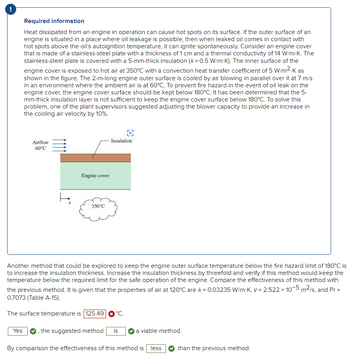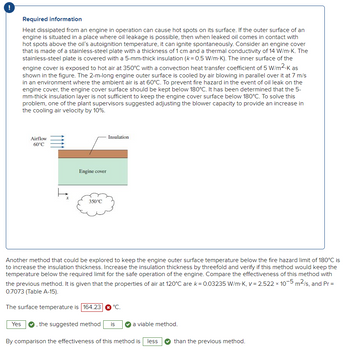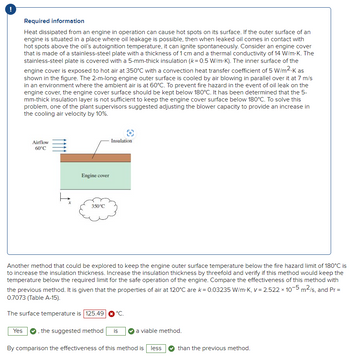Heat dissipated from an engine in operation can cause hot spots on its surface. If the outer surface of an engine is situated in a place where oil leakage is possible, then when leaked oil comes in contact with hot spots above the oil's autoignition temperature, it can ignite spontaneously. Consider an engine cover that is made of a stainless-steel plate with a thickness of 1 cm and a thermal conductivity of 14 W/m.K. The stainless-steel plate is covered with a 5-mm-thick insulation (k= 0.5 W/m-K). The inner surface of the engine cover is exposed to hot air at 350°C with a convection heat transfer coefficient of 5 W/m2.K as shown in the figure. The 2-m-long engine outer surface is cooled by air blowing in parallel over it at 7 m/s in an environment where the ambient air is at 60°C. To prevent fire hazard in the event of oil leak on the engine cover, the engine cover surface should be kept below 180°C. It has been determined that the 5- mm-thick insulation layer is not sufficient to keep the engine cover surface below 180°C. To solve this problem, one of the plant supervisors suggested adjusting the blower capacity to provide an increase in the cooling air velocity by 10%. Airflow 60°C Engine cover 350°C Insulation Another method that could be explored to keep the engine outer surface temperature below the fire hazard limit of 180°C is to increase the insulation thickness. Increase the insulation thickness by threefold and verify if this method would keep the temperature below the required limit for the safe operation of the engine. Compare the effectiveness of this method with the previous method. It is given that the properties of air at 120°C are k = 0.03235 W/m-K, v = 2.522 x 10-5 m²/s, and Pr= 0.7073 (Table A-15). The surface temperature is 152.56 Yes , the suggested method is °C. a viable method. By comparison the effectiveness of this method is less than the previous method.
Heat dissipated from an engine in operation can cause hot spots on its surface. If the outer surface of an engine is situated in a place where oil leakage is possible, then when leaked oil comes in contact with hot spots above the oil's autoignition temperature, it can ignite spontaneously. Consider an engine cover that is made of a stainless-steel plate with a thickness of 1 cm and a thermal conductivity of 14 W/m.K. The stainless-steel plate is covered with a 5-mm-thick insulation (k= 0.5 W/m-K). The inner surface of the engine cover is exposed to hot air at 350°C with a convection heat transfer coefficient of 5 W/m2.K as shown in the figure. The 2-m-long engine outer surface is cooled by air blowing in parallel over it at 7 m/s in an environment where the ambient air is at 60°C. To prevent fire hazard in the event of oil leak on the engine cover, the engine cover surface should be kept below 180°C. It has been determined that the 5- mm-thick insulation layer is not sufficient to keep the engine cover surface below 180°C. To solve this problem, one of the plant supervisors suggested adjusting the blower capacity to provide an increase in the cooling air velocity by 10%. Airflow 60°C Engine cover 350°C Insulation Another method that could be explored to keep the engine outer surface temperature below the fire hazard limit of 180°C is to increase the insulation thickness. Increase the insulation thickness by threefold and verify if this method would keep the temperature below the required limit for the safe operation of the engine. Compare the effectiveness of this method with the previous method. It is given that the properties of air at 120°C are k = 0.03235 W/m-K, v = 2.522 x 10-5 m²/s, and Pr= 0.7073 (Table A-15). The surface temperature is 152.56 Yes , the suggested method is °C. a viable method. By comparison the effectiveness of this method is less than the previous method.
Elements Of Electromagnetics
7th Edition
ISBN:9780190698614
Author:Sadiku, Matthew N. O.
Publisher:Sadiku, Matthew N. O.
ChapterMA: Math Assessment
Section: Chapter Questions
Problem 1.1MA
Related questions
Question
Please help answer the question regarding heat transfer. I tried solving it and came up with 152.56 oC but it says that it is incorrect. Please show how to get the correct answer. Thank you.

Transcribed Image Text:Required information
Heat dissipated from an engine in operation can cause hot spots on its surface. If the outer surface of an
engine is situated in a place where oil leakage is possible, then when leaked oil comes in contact with
hot spots above the oil's autoignition temperature, it can ignite spontaneously. Consider an engine cover
that is made of a stainless-steel plate with a thickness of 1 cm and a thermal conductivity of 14 W/m.K. The
stainless-steel plate is covered with a 5-mm-thick insulation (k= 0.5 W/m.K). The inner surface of the
engine cover is exposed to hot air at 350°C with a convection heat transfer coefficient of 5 W/m².K as
shown in the figure. The 2-m-long engine outer surface is cooled by air blowing in parallel over it at 7 m/s
in an environment where the ambient air is at 60°C. To prevent fire hazard in the event of oil leak on the
engine cover, the engine cover surface should be kept below 180°C. It has been determined that the 5-
mm-thick insulation layer is not sufficient to keep the engine cover surface below 180°C. To solve this
problem, one of the plant supervisors suggested adjusting the blower capacity to provide an increase in
the cooling air velocity by 10%.
Yes
Airflow
60°C
Engine cover
350°C
Insulation
Another method that could be explored to keep the engine outer surface temperature below the fire hazard limit of 180°C is
to increase the insulation thickness. Increase the insulation thickness by threefold and verify if this method would keep the
temperature below the required limit for the safe operation of the engine. Compare the effectiveness of this method with
the previous method. It is given that the properties of air at 120°C are k = 0.03235 W/m-K, v= 2.522 x 10-5 m²/s, and Pr=
0.7073 (Table A-15).
The surface temperature is 152.56 °C.
, the suggested method is
a viable method.
By comparison the effectiveness of this method is less
than the previous method.
Expert Solution
This question has been solved!
Explore an expertly crafted, step-by-step solution for a thorough understanding of key concepts.
This is a popular solution!
Trending now
This is a popular solution!
Step by step
Solved in 5 steps with 1 images

Follow-up Questions
Read through expert solutions to related follow-up questions below.
Follow-up Question
It says surface Temperature is not 125.49oC (look at picture I attached). What would be the correct value? Thank you.

Transcribed Image Text:### Required Information
Heat dissipated from an engine in operation can cause hot spots on its surface. If the outer surface of an engine is situated in a place where oil leakage is possible, then when leaked oil comes in contact with hot spots above the oil’s autoignition temperature, it can ignite spontaneously. Consider an engine cover that is made of a stainless-steel plate with a thickness of 1 cm and a thermal conductivity of 14 W/m·K. The stainless-steel plate is covered with a 5-mm-thick insulation (k = 0.5 W/m·K). The inner surface of the engine cover is exposed to hot air at 350°C with a convection heat transfer coefficient of 5 W/m²·K as shown in the figure. The 2-m-long engine outer surface is cooled by air blowing in parallel over it at 7 m/s in an environment where the ambient air is at 60°C.
To prevent fire hazard in the event of oil leak on the engine cover, the engine cover surface should be kept below 180°C. It has been determined that the 5-mm-thick insulation layer is not sufficient to keep the engine cover surface below 180°C. To solve this problem, one of the plant supervisors suggested adjusting the blower capacity to provide an increase in the cooling air velocity by 10%.
#### Diagram Explanation
- **Airflow at 60°C**: Indicates the direction and temperature of the air being blown across the engine cover surface.
- **Insulation Layer**: A 5-mm-thick layer on top of the engine cover, highlighted for visual reference.
- **Engine Cover**: Main surface potentially exposed to overheating and leakage risk.
- **Temperature Zones**: Noted area with high temperature exposure at 350°C.
### Alternative Method Exploration
Another method that could be explored to keep the engine outer surface temperature below the fire hazard limit of 180°C is to increase the insulation thickness. Increase the insulation thickness by threefold and verify if this method would keep the temperature below the required limit for the safe operation of the engine. Compare the effectiveness of this method with the previous method. It is given that the properties of air at 120°C are:
- \( k = 0.03235 \, \text{W/m·K} \)
- \( v = 2.522 \times 10^{-5} \, \text{m²/s} \)
- \(
Solution
Follow-up Question
It STILL says the answer is wron (see attached photo). Please provide correct answer. Thank you.

Transcribed Image Text:### Required Information
Heat dissipated from an engine in operation can cause hot spots on its surface. If the outer surface of an engine is situated in a place where oil leakage is possible, then when leaked oil comes in contact with hot spots above the oil's autoignition temperature, it can ignite spontaneously. Consider an engine cover made of stainless steel with a thickness of 1 cm and a thermal conductivity of 14 W/m·K. This stainless-steel plate is covered with a 5-mm thick insulation (\(k = 0.5 \, \text{W/m·K}\)). The inner surface of the engine cover is exposed to hot air at 350°C with a convection heat transfer coefficient of 5 W/m²·K, as shown in the figure.
The 2-m long engine outer surface is cooled by air blowing in parallel over it at 7 m/s in an environment where the ambient air is at 60°C. To prevent fire hazard in the event of oil leakage on the engine cover, the engine cover surface should be kept below 180°C. It has been determined that the 5-mm-thick insulation layer is not sufficient to keep the engine cover surface below 180°C. To solve this problem, one of the plant supervisors suggested adjusting the blower capacity to provide an increase in the cooling air velocity by 10%.
#### Diagram Description
- **Diagram Components:**
- **Insulation:** Layer covering the engine cover.
- **Engine cover:** Green rectangle depicted as the main component affected by the hot air.
- **Airflow:** Denotes cooling air at 60°C blowing over the engine cover.
- **350°C Balloon:** Indicates the temperature of the hot air affecting the engine.
### Alternative Method
Another method that could be explored to keep the engine outer surface temperature below the fire hazard limit of 180°C is to increase the insulation thickness. Increasing the insulation thickness by threefold can be examined to check if this method maintains the temperature below the required limit for safe engine operation. Compare the effectiveness of this method with the previous method.
Given properties of air at 120°C:
- \(k = 0.03235 \, \text{W/m·K}\),
- \(v = 2.522 \times 10^{-5} \, \text{m}^2/\text{s}\),
- \(\text{Pr} = 0.7073\) (
Solution
Follow-up Question
It still says the answer is wrong. Can you please solve for the correct answer? Thank you.

Transcribed Image Text:!
Required information
Heat dissipated from an engine in operation can cause hot spots on its surface. If the outer surface of an
engine is situated in a place where oil leakage is possible, then when leaked oil comes in contact with
hot spots above the oil's autoignition temperature, it can ignite spontaneously. Consider an engine cover
that is made of a stainless-steel plate with a thickness of 1 cm and a thermal conductivity of 14 W/m.K. The
stainless-steel plate is covered with a 5-mm-thick insulation (k=0.5 W/m.K). The inner surface of the
engine cover is exposed to hot air at 350°C with a convection heat transfer coefficient of 5 W/m².K as
shown in the figure. The 2-m-long engine outer surface is cooled by air blowing in parallel over it at 7 m/s
in an environment where the ambient air is at 60°C. To prevent fire hazard in the event of oil leak on the
engine cover, the engine cover surface should be kept below 180°C. It has been determined that the 5-
mm-thick insulation layer is not sufficient to keep the engine cover surface below 180°C. To solve this
problem, one of the plant supervisors suggested adjusting the blower capacity to provide an increase in
the cooling air velocity by 10%.
Yes
Airflow
60°C
Engine cover
350°C
Insulation
Another method that could be explored to keep the engine outer surface temperature below the fire hazard limit of 180°C is
to increase the insulation thickness. Increase the insulation thickness by threefold and verify if this method would keep the
temperature below the required limit for the safe operation of the engine. Compare the effectiveness of this method with
the previous method. It is given that the properties of air at 120°C are k = 0.03235 W/m-K, v = 2.522 × 10-5 m²/s, and Pr =
0.7073 (Table A-15).
The surface temperature is 125.49 °C.
, the suggested method is
a viable method.
By comparison the effectiveness of this method is less
than the previous method.
Solution
Knowledge Booster
Learn more about
Need a deep-dive on the concept behind this application? Look no further. Learn more about this topic, mechanical-engineering and related others by exploring similar questions and additional content below.Recommended textbooks for you

Elements Of Electromagnetics
Mechanical Engineering
ISBN:
9780190698614
Author:
Sadiku, Matthew N. O.
Publisher:
Oxford University Press

Mechanics of Materials (10th Edition)
Mechanical Engineering
ISBN:
9780134319650
Author:
Russell C. Hibbeler
Publisher:
PEARSON

Thermodynamics: An Engineering Approach
Mechanical Engineering
ISBN:
9781259822674
Author:
Yunus A. Cengel Dr., Michael A. Boles
Publisher:
McGraw-Hill Education

Elements Of Electromagnetics
Mechanical Engineering
ISBN:
9780190698614
Author:
Sadiku, Matthew N. O.
Publisher:
Oxford University Press

Mechanics of Materials (10th Edition)
Mechanical Engineering
ISBN:
9780134319650
Author:
Russell C. Hibbeler
Publisher:
PEARSON

Thermodynamics: An Engineering Approach
Mechanical Engineering
ISBN:
9781259822674
Author:
Yunus A. Cengel Dr., Michael A. Boles
Publisher:
McGraw-Hill Education

Control Systems Engineering
Mechanical Engineering
ISBN:
9781118170519
Author:
Norman S. Nise
Publisher:
WILEY

Mechanics of Materials (MindTap Course List)
Mechanical Engineering
ISBN:
9781337093347
Author:
Barry J. Goodno, James M. Gere
Publisher:
Cengage Learning

Engineering Mechanics: Statics
Mechanical Engineering
ISBN:
9781118807330
Author:
James L. Meriam, L. G. Kraige, J. N. Bolton
Publisher:
WILEY